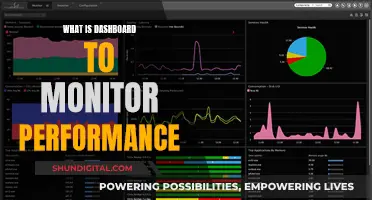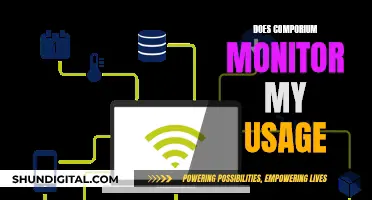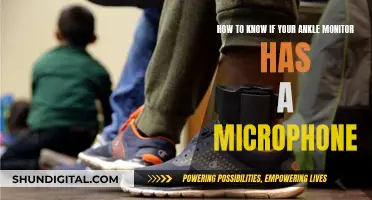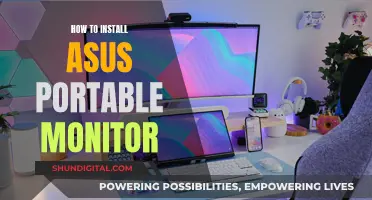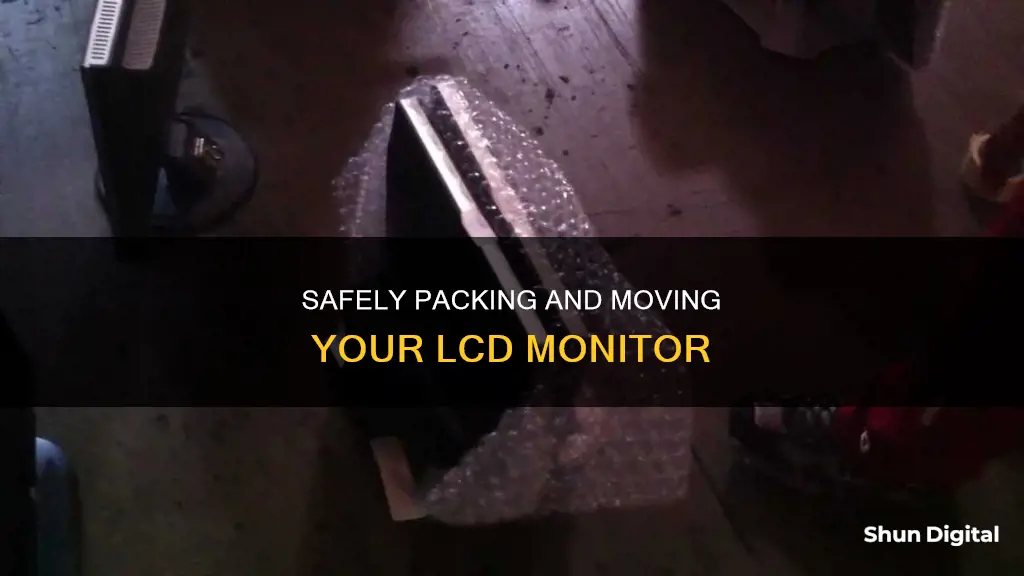
Moving to a new place can be stressful, and while you may be focused on larger items like furniture, it's important to remember that smaller, delicate items like LCD monitors require extra care when packing. The original box is ideal for packing your monitor, but if you don't have it, don't worry – with some careful planning and the right supplies, you can safely transport your LCD monitor to your new home.
| Characteristics | Values |
|---|---|
| First Step | Measure the LCD monitor to determine the box size needed. |
| Box Type | If you don't have the original box, find a sturdy box that is slightly larger than the monitor. |
| Packing Material | Use packing materials such as bubble wrap, foam sheets, or packing paper to wrap the monitor and fill empty spaces in the box. |
| Cardboard | Use cardboard to cover the screen and protect it from damage. |
| Stand | Remove the stand if possible to make the monitor easier to pack and reduce the risk of damage. |
| Cables | Secure loose wires to the back of the monitor with packing tape or a twist tie to keep them organized. |
| Box Position | Place the box containing the monitor upright and ensure it is not at risk of being crushed. Avoid placing it near edges or laying it face down. |
What You'll Learn

Measure the monitor's dimensions to find a suitable box
To pack and move an LCD monitor without its original box, you'll need to start by measuring the monitor's dimensions to find a suitable box for packing and transport. Here's a step-by-step guide to help you through the process:
Measure the Monitor's Dimensions:
- Width: Measure the distance from the left side of the monitor to the right side. Make sure you only measure the screen, excluding the frame or bezel.
- Height: Determine the height by measuring from the top of the screen to the bottom. Again, focus solely on the screen and not the surrounding frame.
- Depth: Measure the distance from the front of the monitor to the back, giving you the depth of the screen.
Finding a Suitable Box:
Now that you have the dimensions of your LCD monitor, it's time to find a box that will accommodate it safely. Here's what to consider:
- Box Size: Look for a box that is slightly larger than your monitor. This will allow you room to add protective packing materials around the monitor. Avoid a box that is too big, as it may cause the monitor to shift during transport. Similarly, a box that is too small will put stress on the monitor and could lead to damage.
- Sturdiness: Ensure the box you choose is sturdy and in good condition. It should be able to withstand the weight of the monitor and protect it from bumps and shocks during the move.
- Packing Materials: You'll need packing materials such as bubble wrap, foam sheets, packing paper, or Styrofoam peanuts to fill any empty space in the box and cushion the monitor.
Once you've found a suitable box and gathered the necessary packing materials, you can move on to the next steps of preparing and packing your LCD monitor for a safe move. Remember to handle your monitor with care and consider asking someone for help if you're unsure about any part of the process.
Connecting a Monitor to Your ASUS: Easy Steps
You may want to see also

Use cardboard to protect the screen
Using cardboard to protect the screen of your LCD monitor is a great idea. It adds an extra layer of protection and helps to keep the screen safe from scratches, dust, and other potential damage during the moving process. Here are some detailed steps and tips to guide you through the process:
Cut the Cardboard to Size
Using the measurements of your LCD monitor's screen, cut out a piece of sturdy cardboard that will fit snugly over the front of the screen. Make sure the cardboard is slightly larger than the screen itself to provide full coverage.
Prepare the Monitor
Before adding the cardboard protection, it is essential to prepare the monitor. Start by removing any cables or cords connected to the monitor. Carefully unplug everything and keep the cords together to avoid tangling. You can even label them to remember where they go. Then, take a soft, dry cloth and gently clean the screen to remove any dust or fingerprints. This ensures that your monitor stays in good condition during the move.
Secure the Cardboard
Once you have cut the cardboard to size, it's time to secure it in place. Place the cardboard snugly against the front of the monitor, ensuring it covers the entire screen. Use tape to hold the cardboard in place. Be careful not to tape directly on the screen, as this could leave residue. Tape the cardboard to the sides or edges of the monitor instead.
Add Bubble Wrap
For added protection, you can also place a layer of bubble wrap over the screen before adding the cardboard. Cut a piece of bubble wrap slightly larger than the screen and place it on a flat surface. Then, centre the monitor on top of it. Secure the bubble wrap around the monitor with clear packing tape. This combination of bubble wrap and cardboard will provide excellent protection for your LCD monitor's screen.
Choose the Right Box
When selecting a box for your LCD monitor, choose one that is slightly larger than the monitor itself. This will give you enough room to add extra padding and ensure the monitor is well-protected. If you don't have a box, you can also use cardboard corners to construct your own. Secure them with shrink wrap or tape to ensure a snug fit around the monitor.
Final Packing Tips
After your monitor is securely wrapped and protected, it's time to place it in the box. Fill any empty spaces in the box with packing material like bubble wrap, foam sheets, or crumpled packing paper. Make sure the monitor doesn't shift around in the box. Once packed, seal the box tightly with packing tape. Label the box as "Fragile" and "This Side Up" to ensure it is handled correctly during the move.
Monitor Size: Understanding Your Screen's Dimensions
You may want to see also

Wrap the monitor in bubble wrap
Wrapping your LCD monitor in bubble wrap is a crucial step in ensuring its safety during the moving process. Here's a detailed guide on how to do it effectively:
Preparing the Monitor:
Before wrapping, it's essential to prepare the monitor. Start by unplugging all cables and cords connected to the monitor. Detach any stands or additional accessories that can be removed. Keep the cords together to avoid tangling and label them if needed, so you remember where they go. Use a soft, dry cloth to gently clean the screen, removing any dust or fingerprints. This preparation ensures the monitor is ready for wrapping and helps maintain its condition during the move.
Wrapping Process:
- Place the bubble wrap on a flat surface: Find a clean, spacious area where you can lay out the bubble wrap. Make sure the bubble wrap is slightly larger than the monitor's dimensions to ensure complete coverage.
- Centre the monitor: Carefully place the LCD monitor face down on the centre of the bubble wrap. Ensure the screen is protected and covered by the bubble wrap.
- Secure the bubble wrap: Use clear packing tape to securely attach the bubble wrap to the monitor. Wrap the tape around the monitor's edges and across the bubble wrap, ensuring all sides are covered. This step will keep the bubble wrap in place and provide additional protection.
- Add extra layers: Depending on the monitor's size and shape, you may need to add more bubble wrap layers. Cover the back and sides of the monitor with additional bubble wrap, ensuring all corners and edges are protected. Secure any loose ends with tape.
- Handle with care: Even with bubble wrap, your LCD monitor remains fragile. Avoid stacking items on top of it and always carry it with care to prevent accidental damage.
Additional Tips:
- If you have the original box, place the wrapped monitor inside, filling any empty spaces with packing material like crumpled paper or Styrofoam.
- If using a different box, ensure it's slightly larger than the monitor to provide room for packing material on all sides.
- Always move the box containing the monitor in an upright position to avoid putting stress on the screen.
Unlocking ASUS Monitor: Stuck at 60FPS, Why?
You may want to see also

Secure loose wires to the monitor
When packing an LCD monitor for moving, it is important to secure loose wires to the monitor to prevent them from getting tangled or pulled out during transit. Here are some detailed steps and tips to help you secure the wires effectively:
Use clear packing tape: After wrapping your monitor with bubble wrap, use clear packing tape to secure any loose wires to the back of the monitor. Ensure that the tape is strong enough to hold the wires in place and prevent them from moving around.
Bundle cords together: Use twist ties, zip ties, or cable ties to bundle cords together neatly. This will help keep them organised and tangle-free. You can also use garbage bag twist ties to tie the wires together.
Protect cords: Wrap the bundled cords in bubble wrap and secure them with packing tape. This will provide an extra layer of protection and ensure that the cords do not get damaged during the move.
Use zip tie mounts: If you want a more secure option, consider using zip tie mounts in addition to zip ties. This combination will allow you to add cable routing to a case that may not have any built-in routing options.
Avoid electrical tape: While electrical tape may seem like a convenient option, it is not ideal for securing wires. The tape will eventually come loose, and it may not provide enough support for the wires.
Label the cords: Before securing the wires, label each cord to make it easier to identify and connect them correctly when setting up the monitor at your new location.
Place cords in a separate bag: If you prefer to keep the cords separate from the monitor, you can place them in a bag and secure the bag inside the box. This will ensure that the cords remain organised and protected during the move.
By following these steps and tips, you can effectively secure loose wires when packing and moving an LCD monitor without the original box. Remember to be gentle when handling the wires and to use the appropriate amount of tape or ties to avoid damaging the wires or the monitor.
The Benefits of a Large Monitor Setup
You may want to see also

Pack the monitor upright with soft items
When packing an LCD monitor for moving, it's important to remember that the screen is the most delicate part. To protect it, you should wrap the monitor with a layer of bubble wrap, ensuring complete coverage. Secure the bubble wrap with packing tape, being cautious not to tape too tightly to avoid putting pressure on the screen.
Once your monitor is wrapped up, you can place it upright in a box surrounded by soft items like pillows, blankets, or other lightweight boxes. This will add an extra layer of protection and minimise the risk of damage during transit. Make sure the box is sturdy and slightly larger than the monitor itself, giving you space to add extra padding and protect the monitor from any bumps during the move.
Fill any empty spaces in the box with additional packing materials, such as crumpled newspaper or packing peanuts, to prevent movement during transit. Label the box with clear instructions, marking it as "Fragile" and indicating that it should be kept upright during the move.
By following these steps, you can help ensure that your LCD monitor arrives at its destination safely and securely.
Dismantling Your ASUS 24" Monitor: Step-by-Step Guide
You may want to see also
Frequently asked questions
You will need a sturdy box that is slightly larger than the monitor, bubble wrap or packing paper, packing tape, and cardboard. First, wrap the monitor in a towel or protective wrap, then place bubble wrap over the screen with a piece of cardboard snug against the front. Use cardboard corners to construct your box and tape or shrink wrap to secure it. Fill any empty space with packing paper or bubble wrap.
Before you start wrapping your monitor, carefully unplug all cables and cords and keep them together so they don't get lost or tangled. You can use a twist tie to keep them together.
Using the screen measurement, cut out a piece of thicker cardboard that will fit over the front of the monitor. You can tape this in place to help keep it secure.
If your stand is detachable, remove it and pack it separately. Wrap it in bubble wrap or a towel to protect it from damage.
Place the box containing the monitor upright and ensure it is surrounded by softer items like pillows, blankets, or other lightweight boxes to prevent movement and minimise the risk of damage.


